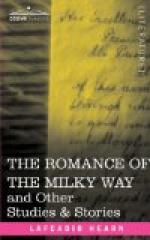Amanogawa,
Ai-muki tachit[’e],
Waga ko[:i]shi
Kimi kimasu nari—
Himo-toki makina![5]
It would seem that the Tanabata festival was first established in Japan eleven hundred and fifty years ago, as an Imperial Court festival only, in accordance with Chinese precedent. Subsequently the nobility and the military classes everywhere followed imperial example; and the custom of celebrating the Hoshi-mat-suri, or Star-Festival,—as it was popularly called,—spread gradually downwards, until at last the seventh day of the seventh month became, in the full sense of the term, a national holiday. But the fashion of its observance varied considerably at different eras and in different provinces.
[Footnote 5: For a translation and explanation of this song, see infra, page 30.]
The ceremonies at the Imperial Court were of the most elaborate character: a full account of them is given in the K[=o]ji Kongen,—with explanatory illustrations. On the evening of the seventh day of the seventh month, mattings were laid down on the east side of that portion of the Imperial Palace called the Seir-y[=o]den; and upon these mattings were placed four tables of offerings to the Star-deities. Besides the customary food-offerings, there were placed upon these tables rice-wine, incense, vases of red lacquer containing flowers, a harp and flute, and a needle with five eyes, threaded with threads of five different colors. Black-lacquered oil-lamps were placed beside the tables, to illuminate the feast. In another part of the grounds a tub of water was so placed as to reflect the light of the Tanabata-stars; and the ladies of the Imperial Household attempted to thread a needle by the reflection. She who succeeded was to be fortunate during the following year. The court-nobility (Kug[’e]) were obliged to make certain offerings to the Imperial House on the day of the festival. The character of these offerings, and the manner of their presentation, were fixed by decree. They were conveyed to the palace upon a tray, by a veiled lady of rank, in ceremonial dress. Above her, as she walked, a great red umbrella was borne by an attendant. On the tray were placed seven tanzaku (longilateral slips of fine tinted paper for the writing of poems); seven kudzu-leaves;[6] seven inkstones; seven strings of s[=o]men (a kind of vermicelli); fourteen writing-brushes; and a bunch of yam-leaves gathered at night, and thickly sprinkled with dew. In the palace grounds the ceremony began at the Hour of the Tiger,—4 A.M. Then the inkstones were carefully washed,—prior to preparing the ink for the writing of poems in praise of the Star-deities,—and each one set upon a kudzu-leaf. One bunch of bedewed yam-leaves was then laid upon every inkstone; and with this dew, instead of water, the writing-ink was prepared. All the ceremonies appear to have been copied from those in vogue at the Chinese court in the time of the Emperor Ming-Hwang.




